Blog posts tagged microsoft
Windows XP is dying - here's what you need to do
 Are any computers in your business still running Windows XP? If so, listen up. The information in this blog post could help your company avoid unnecessary risks over the next few weeks.
Are any computers in your business still running Windows XP? If so, listen up. The information in this blog post could help your company avoid unnecessary risks over the next few weeks.
As you might be aware, Microsoft is retiring Windows XP on 8 April 2014. After that date, Windows XP will no longer receive updates from Microsoft.
Security issues will not be fixed and bugs will no longer be resolved.
You can keep using Windows XP after 8 April, but that would be taking a gamble. With Microsoft no longer actively fixing security vulnerabilities, you can bet hackers will redouble their efforts to find new holes in Microsoft’s venerable operating system.
You must replace Windows XP
If your company is still using Windows XP, it’s not alone. By some estimates, worldwide there could be 100 million computers still running Windows XP when Microsoft pulls the plug. (Somewhat worryingly, 95% of cash machines are based on XP, although they tend to use a special version that will remain supported for a couple more years.)
For you, by far the safest option is to stop using Windows XP by 8 April. But how?
Well, if your computers are under four years old, it should be possible to upgrade them to a more recent version of Windows. (You might consider a memory upgrade, too.)
Microsoft is keen to push users towards Windows 8. However, it’s still possible to buy Windows 7 from some suppliers. Many people prefer this because the interface is more familiar if you're used to XP.
If your computers are getting long in the tooth anyway, it’s probably time to bite the bullet and invest in some new hardware. New computers are typically cheaper to maintain than older machines, which are more likely to break down.
Before you upgrade, check software compatibility
Before you rush out to buy new copies of Windows and install them on your computers, it’s important to do a few checks.
First of all, make sure all your current software and data will work with the new version of Windows you choose. Some older software packages don’t play nicely with newer versions of Windows.
Pay particular attention to business-critical applications, like your customer database or accounting software.
If you find software compatibility is going to be a problem, consider upgrading that software too, or switching to a different package.
It’s not too late to get Windows XP help
It’s wise to speak to an IT supplier. They can help you understand your options and make sure you haven’t missed anything that might cause problems.
For example, it’s not possible to install Windows 8 straight over Windows XP. You must perform what’s called a ‘clean installation’. This gives you the Windows 8 default settings, instead of carrying your existing settings over.
A good IT supplier may also be able to buy you some breathing space. For instance, in the short term you might continue running Windows XP on a computer that’s not connected to the internet, so hackers can’t attack it.
There’s plenty of official advice on the Microsoft website, although keep in mind that this will push you towards Windows 8 instead of Windows 7. If you’re not sure which version of Windows you have, you can also use Am I running XP? to see if you need to worry about upgrading.
Finally, a number of IT manufacturers are offering deals or trade-in programmes to businesses ready to move away from Windows XP. There’s a good round-up on the PC Pro website.
The end of Windows XP: what you need to know
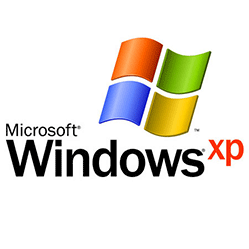 Microsoft recently reminded Windows XP users that this venerable operating system is being retired in April 2014.
Microsoft recently reminded Windows XP users that this venerable operating system is being retired in April 2014.
Windows XP has just passed its 12th birthday, and on 8 April next year Microsoft will end support for it. If you’re still using it, this means you will no longer receive security patches or updates — and Microsoft won’t be able to provide you with any sort of support for Windows XP.
Time to ditch Windows XP
Because Microsoft will no longer be updating Windows XP to guard against new security threats, it’s important to move away from the software before April next year.
This may pose a challenge for any companies still using Windows XP — and there are plenty of those. Despite just passing its twelfth birthday, according to Net Market Share Windows XP is still the second most popular operating system, with a significant 31% market share.
XP has been a great choice for businesses. It was relatively easy to pick up because it feels familiar to many users and supports a lot of bespoke business software. As a result, many businesses have been reluctant to upgrade.
Software has moved on
However, desktop software has come a long way since Windows XP was released in October 2001. So has hardware. In fact, Microsoft released three new versions of Windows over those 12 years: Windows Vista, Windows 7 and Windows 8.
Vista never really gained a foothold with businesses, but Windows 7 now enjoys considerable market share.
How to cope with the end of XP
If you currently use Windows XP on any of your business computers, it’s time to take action. Don’t put it off — once Microsoft drops support for Windows XP, so will many other software companies. You could soon find you’re unable to run some of your key business software.
More worryingly, in six months time you will be at an increased risk from malware and viruses, as hackers begin to target the unmaintained operating system. Consider your options now and plan to replace Windows XP before the deadline.
Upgrading Windows XP: your options
The most recent Microsoft operating system is Windows 8. It has a significantly different interface compared to its predecessors and has attracted some criticism for this, so you may be more comfortable upgrading to Windows 7, with its familiar look and feel.
There are also hardware factors to consider when you upgrade. A computer running Windows XP is likely to be as dated as the operating system itself.
Even if it can handle a newew operating system, it’s likely to be considerably slower than Microsoft intended — and this could hit your productivity. The end of Windows XP could therefore be a good time to replace your business computers, too.
Can we keep using Windows XP?
On the morning of the 9 April, your Windows XP computers will still start up as they have done for the past decade. However, the lack of support and updates — not to mention the increased threat of malware — should be enough to put you off of doing so.
Quite simply, after 8 April, the longer you hold on to Windows XP, the greater the chance you’ll suffer some sort of problem or catastrophe from which it’s hard to recover.
Microsoft is keen to see businesses upgrade, as this allows it to focus resources on developing new software, rather than maintaining older versions. However, it costs to upgrade, so there’s certainly a commercial incentive too.
In all, Windows 8 is a considerably more advanced and future-proof operating system than Windows XP. If you’re currently persevering with this old software, there’s no better time to make the leap and upgrade.
- Does your business need Windows 8?
- Will you have to upgrade to Windows 8?
- ISS it time to ditch Microsoft Windows altogether?
This is a guest post from Adrian Case, technical director at Akita IT support in Kent.
Microsoft's 'proper' Windows tablet is here. Almost.
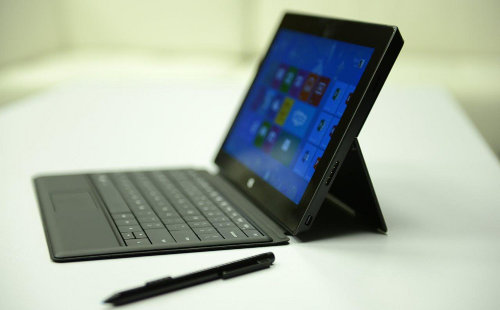
A few months ago we took a good look at the Microsoft Surface RT. This tablet computer from Microsoft is nicely built and well-rounded, but it has one glaring problem.
Although it runs a version of Windows called Windows RT, it can only run special Windows RT apps, and not your standard Windows software.
Buy a Surface ProMicrosoft Surface should be available direct from Microsoft from 23 May. The entry-level model will cost £719, and you can add a touch cover (with keyboard) for an extra £80. |
On the basis that a key reason to buy a Windows tablet is to run traditional Windows software, we reckoned most businesses would want to wait until the Surface Pro was released.
(If you do want a Windows RT tablet, Dell's XPS 10 is cheaper in any case.)
The Surface Pro is a more powerful model that does have a 'proper' version of Windows on it. This means it can run all your standard Windows software.
It's been available in the US since February, but Microsoft has finally announced it'll be available this side of the Atlantic from Thursday.
Surface Pro is your computer
Surface is a big bet for Microsoft. So far the software giant has struggled to make inroads into a tablet market dominated by Apple and Google, and it hopes this device will change that.
And maybe, just maybe it will. Initial reviews are reasonably positive.
Microsoft has done something genuinely different, building what's effectively a fully-functional Windows PC into a device that works like a tablet. While you'd struggle to use an iPad or Android tablet as your only business computer, Surface Pro can do the job pretty well.
That's because it's built from similar components as many of the super-light, super-thin ultrabook laptops on the market. The only difference is that Microsoft has crammed those components into a tablet device with an optional detachable keyboard.
Plug in a mouse, keyboard and external screen and you can quite happily use it as your main computer while you're in the office. But disconnect it and it's good to slip in your bag - even if it is a good bit thicker and heavier than other tablets of this size.
Available this week
And I think that's where the Surface Pro sits in the market. With prices starting at £719 (plus another £100 or so for the keyboard), Surface Pro isn't really a direct competitor to Apple's iPad, which starts at £399.
But if you're in the market for a thin, light laptop, maybe you'd consider opting for the added tablety flexibility of a Surface Pro instead. PC Pro and the Daily Telegraph both have in-depth reviews to help you decide.
ISS it time to ditch Microsoft Windows?
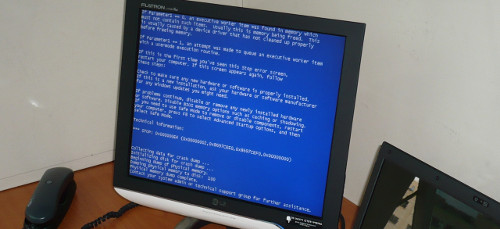
The Windows blue screen of death. Seen one lately? (Image: namho on Flickr.)
We tend to focus on Microsoft Windows here on IT Donut. Although there are many alternative operating systems that are reliable capable and even free (like Linux), we've taken the view that it's easiest for small firms to stick with the status quo.
Quite simply, Microsoft Windows is one of the few pieces of software that's used almost universally by companies across the UK. Sit a new member of staff in front of a computer running Windows and there's a good chance they'll know how to use it.
Windows gets the job done
IT dealsSee the latest business tech bargains we've found online. Or buy IT equipment now from these trusted suppliers: |
That's not to say for a moment that Windows doesn't have its problems. From the famed blue screen of death (see image) to the ridiculous Windows Update system that seems designed to kill productivity dead, Windows can be frustrating at times.
But by and large it gets the job done. And although it's arguable that the dominance of Windows has stifled innovation, if you're just trying to get stuff done then there's a lot to be said for having what pretty much amounts to a standard operating system.
Is change in the air?
However, having said all that, we're starting to wonder if change might be in the air. The ties that bind that businesses to Microsoft Windows may be loosening. Here's why:
- Although Windows dominates laptop and desktop computers, the picture's less rosy in smart phones and tablets. Apple and Google command the lion's share of these emerging markets. This means that as more businesses use tablets and smart phones in place of traditional computers, Windows may become less crucial for business.
- Windows 8 - the latest version of Windows - has an entirely new interface, which means bits of it are like learning to use a new operating system. Many companies seem reluctant to upgrade. Is it too much of a leap to imagine them considering entirely new operating systems?
- The cloud is making Windows less important. You can use online cloud services to replace much of your traditional software. These work on any computer, regardless of the operating system. They just run inside a web browser. Google's Chromebook works on this principle. Could it be the future of business IT?
But one story emerged this week that'll bring cheer to opponents of Windows, particularly those who prefer to use Linux. As it turns out, the International Space Station (ISS) is moving from Windows to Linux in order to improve reliability.
And let's be honest. If it's good enough to run the ISS, it's probably good enough for your average business.
The end is near for Windows XP

The end is nigh for Windows XP
If your business is one of the millions still using Windows XP, it's time to start thinking about moving to a more modern operating system.
Actually, you can consider this your early warning that Microsoft will be ending support for Windows XP in just under a year's time, on 8 April 2014.
After that date, Windows XP will no longer receive software updates from Microsoft.
That means no more security patches to protect you from viruses, spyware and hackers. No more fixes for software bugs. And no more updates to improve performance and stability.
Windows XP: 11 years and counting
Upgrading WindowsIf you're using Windows XP, you can upgrade to Windows 7 or Windows 8. It's a good idea to discuss the options with a reputable IT supplier. You can purchase Windows from these outlets: |
If you keep using Windows XP after 8 April next year then it will keep on working, probably. But the longer you keep using it, the greater the risk you'll be running.
The truth is Windows XP is more than 11 years old. Business technology has changed immensely in that time, and you're still reliant on this outdated software then you'll be doing yourself a real favour by upgrading.
If your computers are under three years old then you should be able to upgrade them to a more recent version of Windows without needing to invest in new computer equipment.
If your computers are older than that, then you might benefit from investing in new hardware at the same time.
Have the conversation now
In either case, it's worth discussing the issue with your IT supplier or support company now, so you have an idea of what you might need to do over the next few months.
You'll probably be presented with the option of upgrading either to Windows 7 or 8.
Windows 7 is a couple of years old and has been tried and tested in companies of all sizes. Windows 8 is the newest version, but has a revised interface that takes a little getting used to.
Which option is right for you will depend on the compatibility of your existing software, and your own preferences.
Don't panic though - you're hardly the only business out there still using Windows XP. Some statistics suggest nearly 40% of businesses are still are using the venerable software, with many experts expecting most of these companies to choose Windows 7 over Windows 8.
Do you still use Windows XP? Are you worried about the end of support?
Has Microsoft Surface won the laptop vs. tablet debate?

Small businesses traditionally stick with laptops, does Microsoft Surface mean they’ll now get the benefits of tablets too?
Tablets have really taken off in the past couple of years, with all of the major computer brands now in the market. Apple recently released its iPad Mini, and a number of other manufacturers have really upped their game.
Laptop or tablet?
The debate rages over whether these new tablets or traditional laptops are better for business. The real solution however, could lie with Microsoft’s new Surface: a tablet with laptop power and capabilities.
The overall consensus has been that tablets are best suited to displaying or digesting information, whereas laptops are better for business applications. The intrinsic tactility of a tablet suits it to presentation, while the superior power and setup of a laptop suits it to actual work.
Surface Pro then, the forthcoming model that runs the full version of Windows 8 (don't get it confused with the Surface RT, reviewed recently on this blog), is a hybrid of sorts.
It can be used as a sleek and attractive tablet, ideal for passing round a boardroom. But attach the keyboard and it should be a more effective workstation than any other tablet can hope to be.
Your business apps, anywhere
Fans of laptops will be pleased to see that Surface Pro will come equipped with an Intel i5 processor; a mid-level central processing unit that you’ll find in many modern laptops.
It will mean the Surface should be capable of handling a raft of traditional Windows software with ease, which is something most tablets can’t currently do. The clip-on keyboard is proving very popular, as it instantly turns the tablet into a workstation.
However, the real benefit of having a Windows operating system is, of course, that all your usual software should work on Surface Pro too.
Surface criticisms
Criticisms of the Surface are mainly aimed at its tablet aspects. For instance, reviews have suggested Surface is not as capable of displaying information attractively as rivals such as the iPad.
If you’re looking to impress clients, it seems that the offerings from Apple are a better choice. This is partly down to screen quality and Apple's slick interface.
The other criticism is the price. In particular, refurbished laptops offer a lot more power in terms of relative cost. If you’re looking to issue several members of staff with a computer, a laptop is by far the most cost effective option.
In conclusion, it appears the debate is far from over. Surface is a go-between, but it is not as good as either a tablet or a laptop for their respective specialities. The decision of which to buy probably relies on what you’re going to be using the computer for.
If you have a desktop and just need something to present information to customers on, then a tablet is best. If you need to be able to work on the go, then a laptop is probably essential. For something in between, Surface may do nicely.
Surface Pro will be available to buy from Microsoft from January. The price is expected to be around £700.
- Should you buy a Microsoft Surface?
- Windows 8 to spark tablet war?
- Now is when the tablet comes of age for business
Adam Hart-Davies is a computer enthusiast who writes on behalf of SCH Trade, who supply excellent value refurbished laptops.
Should you buy a Microsoft Surface?

Microsoft Surface, complete with Touch Cover
Should you buy a Microsoft Surface, the tablet computer Microsoft launched alongside Windows 8? Billed as an iPad beater, Surface is the tech giant's big bet to carve itself a space in the tablet market.
A month after the tablet hit the shelves, we've trawled the web to try and answer the question: should you buy a Microsoft Surface?
Buy a Microsoft SurfaceMicrosoft Surface is available direct from Microsoft. Most other online IT firms don't currently sell it. The entry-level model costs £399, but we'd recommend adding the Touch Cover for an extra £80. |
Design
Surface is boxier and slightly heavier than most of its rivals, but none the worse for it. Most reviews agree it has a distinctive design, with a clever kickstand that supports the tablet in portrait mode. PC Pro's Barry Collins explains:
"The mechanics of the kickstand are beautifully simple. The bottom half of the back of the tablet casing flicks out to create a stand, turning the device into a pseudo-laptop when used with one of the keyboards."
Ah yes, the keyboard. The Touch Cover is a thin screen cover for Surface that incorporates a touch-sensitive keyboard. It costs £100 if you buy it separately (and you'll almost certainly want one if you're going to buy a Microsoft Surface). There's also a thicker Type Cover (£110) which features a more traditional keyboard.
Review sourcesWe referred to these Microsoft Surface reviews when compiling this blog post: |
PC Advisor tried both:
"The Touch Cover is strange to use at first but is something you can get used to after a while. It's just 3mm thick and uses pressure-sensitive touch pads. The Touch Cover is fine for the odd bit of typing but anyone wanting to do any serious work will benefit no end by opting for the Type Cover."
In general, reviews praise the design and build quality of Surface, putting it up there with other leading tablets like Apple's iPad.
Software and apps
Surface runs a special version of Windows called Windows RT. This caused some consternation among reviewers, because it means Surface can't run the Windows software you already own.
Next year you'll be able to buy a Microsoft Surface that's thicker, heavier and able to run standard Windows apps. CNET UK's Andrew Hoyle explains:
"...you can only use software from the Marketplace app store, which is missing many big-name apps and is currently a low priority for most developers,"
Similarly, Information Week, complained about some obvious omissions:
"There are a lot of go-to apps that still aren't there. Microsoft's SkyDrive was the only cloud storage service available on day one, though DropBox was added shortly after. Others, like Google Drive and Carbonite, still aren't available. There's still no dedicated YouTube app. Social media staples like Twitter, Facebook and LinkedIn are absent..."
TechRadar agrees, in more scathing fashion:
"Windows RT won't run old PC programs [...] It has the potential to cause mass confusion and the power to sink Microsoft's figurehead before it's even taken off."
Having said that, Surface can run a special version of Microsoft Office, which is not available for non-Windows tablets.
Display and interace
On paper, Surface has a distinctly average screen. It's not as crisp as the iPad's Retina screen, nor as sharp as the displays found in many other tablets, like Google's Nexus.
However, as is often the case when it comes to displays, the screen's specifications don't tell the whole story. CNET found it well up to most jobs:
"I found it to be perfectly sharp enough for working on documents in Office, or indeed in Google Docs. Videos looked crisp, clear and bold, thanks to the display's good use of colour. It doesn't excel in any area, but it's a decent all-rounder."
Ease of use and performance
As we've mentioned before, Windows 8 has been designed for touch screens. And if you buy a Microsoft Surface, you'd expect it to make full use of these touch-enabled features. Wired found this aspect of the interface doesn't disappoint:
"It is delightfully gesture-friendly, and Microsoft has clearly spent much time thinking about and creating an entirely new interface."
However, Windows RT also incorporates elements from older versions. Most prominent is the old-skool Windows Desktop, which you have to use in order to run Microsoft Office. ZDNet found this is where the interface suffers:
"...any time you're forced to use the desktop interface (safely removing a USB stick or accessing Task Manager are other examples), you'll have an experience akin to finding a hand-crank starter on an otherwise sleek and modern-looking automobile"
Expert Reviews judged the tablet's speed and performance to be fine in general use, but discovered the Surface slows down when asked to perform more demanding tasks:
"In general use the tablet is as responsive as an iPad, with touch elements and web pages gliding around under your fingers [...] but the moment you try to do anything serious in Office things start to chug a little, while demanding 3D games such as Pinball FX 2 didn’t run as smoothly as we expected."
Verdict
Surface is a really interesting prospect. Microsoft should be commended for creating a tablet that does things a bit differently. The Touch Cover and kickstand are genuinely innovative and useful, and for day-to-day internet use you won't be disappointed if you buy a Microsoft Surface.
The ultimate vision of creating an environment in which software and files can move seamlessly from tablet to PC and back again is also attractive. But Microsoft isn't quite there with Windows RT. The mix of touch and traditional interface elements can be jarring, and there are notable omissions from available apps.
Those gaps are likely to get filled over time, and when Surface becomes available with the full version of Windows 8 next year you'll be able to run all your usual Windows software too.
If Microsoft manages to get that experience right, that's when Surface will become a compelling business tool. And that's why most businesses will probably want to buy a Microsoft Surface only once that new model becomes available.
You can buy a Microsoft Surface online now. Prices start from £399.
Five Windows 8 features that could benefit your business
 Windows 8 is here. Well, just about. The launch event takes place this afternoon, and the good folk over at PC Pro are covering the whole thing via their live blog.
Windows 8 is here. Well, just about. The launch event takes place this afternoon, and the good folk over at PC Pro are covering the whole thing via their live blog.
Although the launch is today, it's a fair bet that many companies will put off upgrading their computers to Windows 8. Historically, it's been a good idea to let Microsoft iron out any teething problems first. (If they're happy with Windows 7, plenty of companies will probably hold off for Windows 9.)
Key Windows 8 features
How to get Windows 8You can upgrade to Windows 8 for £14.99 if you bought a PC with Windows 7 on or after 2 June. If you have Windows XP or later, you can upgrade to Windows 8 Pro for £24.99 until 31 January. You must download the software from Microsoft to claim this price. Alternatively, retailers like PC World Business, eBuyer, Dabs and Misco all sell Windows 8. Your IT supplier may be able to advise on which edition is best for you. |
As with any new software, there are lots of new features. Most obvious - and controversial - is the new interface.
It's bye-bye to the Start menu, and a distinct relegation for the desktop, which is to be replaced by a touch screen-inspired interface. We wrote about this a week or so back.
But there are lots of other changes too. Here are five of the most important:
1. Live tiles
What is it?
This is part of that famous new interface, once dubbed Metro, now being referred to simply as the Windows 8 user interface (snappy, eh?).
The key change is that your desktop is replaced by a screen of tiles. You can click them to launch apps, but they can also show information in real-time.
Emails, diary appointments, tweets, Facebook updates, web analytics - live tiles could be like a dashboard for your business.
Is it any use?
Yes, abosolutely. It can be an at-a-glance guide to all the things that matter to you. That's assuming you decide to opt for the new interface and don't just switch it off in favour of the old-fashioned desktop, of course.
2. Windows To Go
What is it?
Effectively, Windows To Go lets you carry your computer on a USB memory stick. Just pop it into another PC and your desktop will open, complete with all your programs, files and everything.
You'll need to be signed up for a Microsoft Account for it to work propery, because Windows To Go will need to transfer files and settings to the PC you're using over the internet. But the idea is you can pop your USB drive into a PC - almost any PC - fire it up and start working with your usual desktop.
Is it any use?
If could be good for a business that wants to let employees use their home PCs for work. It should be an effective way to keep personal and business data separated in that scenario.
But I think take-up will be limited outside the IT professional market. Many firms will just prefer to issue laptops to staff.
3. Secure boot and built in anti-virus
What is it?
Microsoft is ramping up security, adding a new start-up procedure which blocks viruses from running the moment a PC starts up. Windows 8 will also come with integrated security software, so many companies will feel they can do without third-party security software.
It should all add up to an operating system that's safer from viruses and other threats.
Is it any use?
At face value, yes. The only slight worry is that if everyone ditches third-party security software, life might become easier for the creators of computer viruses, because they'll only have to worry about getting round a single security package.
4. Restore PC
What is it?
If your computer's suffering problems or running slowly, this feature makes it much easier to revert to a clean copy of Windows without deleting your data and files in the process.
Is it any use?
If you've ever wasted the best part of a day wiping your computer, reinstalling Windows and then restoring all your software, you'll appreciate this. Of course, if you take good care of your computer and don't install stuff willy-nilly then you shouldn't have to use it.
5. Faster boot times
What is it?
Microsoft has changed the way Windows starts, claiming that Windows 8 takes up to 70% less time to start up than Windows 7.
Is it any use?
It's not going to have you lining up to upgrade, but if it stops those 'I'll just go and have a cup of coffee' moments as you wait for your computer to start up in the morning then it'll certainly have benefits.
There are, inevitably, lots of other improvements and changes to Windows 8. More information is available over on the Microsoft website (along with an intriguing picture of a bearded man next to a giant floating tablet computer).
We'll have another blog post looking at some of the benefits of Windows 8 tomorrow.
What we can all learn from Microsoft's new homepage
Over the years Microsoft's homepage has had many different designs. The software giant unveiled another recently, and it applies responsive web design, a relatively new technique that could be on the cusp of going mainstream.
A responsive website is one that automatically tailors its design and layout to fit whatever size screen it's being viewed on. Responsive web design came about because modern websites have to cater for people using a huge variety of screen sizes, from tiny phones to monster widescreen displays.
The best way to see what this means in practice is to visit Microsoft's homepage and watch how the layout changes as you resize your web browser window.
On the left is Microsoft's homepage in a full-screen window. On the right, how it looks on a narrower display:
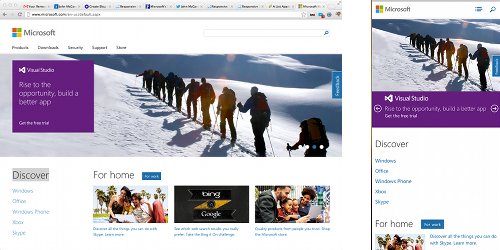
Responsive web design has been championed by cutting edge web designers since 2010, but so far it's not been adopted by many big websites. This move by Microsoft could mark a turning point for the technique. Don't be surprised to see other big-name sites go the same way in the next six months.
Advocates of responsive web design say that as screen sizes continue to diversify, it's the only sensible way forward. Sure, you can create a mobile website that works fine on a small screen, but what about mobile phones with larger screens? What about tablet computers, which can have anything from a 6" screen to a 12" screen?
There's a message here for your business, particularly if you're looking to redesign your website. It's really important to think about how to cater for different devices (read why it matters here), and a responsive approach is a great way to do this.
It gives you more flexibility than creating a separate mobile website, because it will work on screens of all sizes. What's more, you don't have to worry about maintaining two different sites.
To learn more about responsive web design, there's a good introduction here. To see some real-world examples of responsive sites, check out Media Queries.
Windows 8 to spark tablet war?
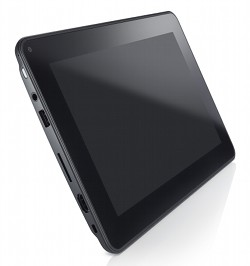 It's rather got lost in all the recent hype over iPhone 5, but Windows 8 - the next version of Microsoft's dominant operating system - will be available from 26 October.
It's rather got lost in all the recent hype over iPhone 5, but Windows 8 - the next version of Microsoft's dominant operating system - will be available from 26 October.
It can be a risky business being first to adopt a new Windows version. As with any major new software, there are usually a few bugs that need ironing out. Canny companies hold off upgrading until these teething problems are solved.
Windows on a tablet
Having said that, a big Windows 8 push is just round the corner. And it's not just from Microsoft. There are plenty of hardware companies hoping Windows 8's innovative new interface and touchscreen features will drive up their sales too.
What's more, Windows 8 is the first version of Windows to cater seriously for tablet computers. There will be lots of new features to take advantage of touchscreens, and so one exception to the 'don't be first to buy it' rule might be if you want a new tablet computer.
A new tablet from Dell
Take Dell. Anticipating a Windows 8 buzz, the hardware giant has just announced a new tablet that'll launch on the same day as Windows 8. It's the Latitude 10, and it promises to make the most of the tablet-focused features in Windows 8.
Done right, a Windows 8 tablet could be ideal for smaller companies. It should give them all the convenience of a tablet without requireing them to learn how to use lots of new software, or convert files between different formats.
Sure, our experiences with Windows 7 tablets have been underwhelming, but initial reports suggest Windows 8 will be an entirely different beast.
Security in a crowded market
Expect tablets like the Latitude 10 to be of particular interest to companies which handle lots of sensitive data. Dell's tablet puts a big emphasis on security, with support for two-factor authentication. This means you need something you know (like a password) and something you have (like your fingerprint or a smart card) to log in.
But it will be a crowded market. There's Apple's iPad (from £399), of couse. But recent months have seen Google (from £159) and Amazon (from £129) launch keenly-priced tablets. Even Microsoft will be launching a Windows 8 tablet. As Windows 8 draws closer, more Windows tablets will join the fray.
This all means now's a great time to keep an eye on the market, particularly if you like the idea of having a tablet but aren't quite convinced yet. Windows 8 will prompt new models, extra competition and - with luck - some aggressive pricing and innovative features.
Surface and Nexus: tech giants get into tablets
Any doubts about whether tablet computers have a future have faded. Apple's iPad might have seemed like a bit of a gamble when it was first announced, but it's been an enormous success.
For proof, you can check the company's impressive sales figures or simply count the number you spot next time you're on a long train journey.
You can also look at new tablet devices. Everyone wants a slice of the action, and recently we've seen two major announcements which could shake up the tablet world.
Microsoft Surface
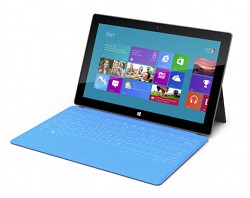 Microsoft revealed its new tablet computer, Surface, at a hyped-up media event in LA. Surface is a touch-screen tablet computer which Microsoft has designed and built itself. That's a real departure for a company which usually focuses on software.
Microsoft revealed its new tablet computer, Surface, at a hyped-up media event in LA. Surface is a touch-screen tablet computer which Microsoft has designed and built itself. That's a real departure for a company which usually focuses on software.
Surface will come in two flavours: one running a cut-down version of Microsoft Windows for mobile devices, the other running a full-blown version of Windows.
Initial reactions to Surface have been positive: the 11" device looks sleek and capable and has a retro rubber keyboard which doubles as a screen cover. But it won't be available for months, and as no details are available about battery life or price it's hard to judge it fairly.
Having said that, the next version of Windows is meant to be tablet friendly. If it really is (previous attempts have been less than impressive), Surface could be a real contender for business use, because you'll be able to run all your usual Windows apps.
Microsoft Surface is not yet available, and prices are still to be confirmed.
Google's Nexus 7
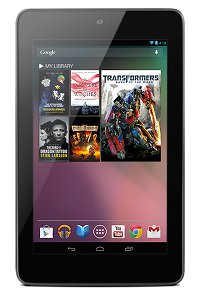 The other tech giant to jump on the tablet bandwagon this week was Google, which showed off its Nexus 7 tablet. With a smaller screen (7") and prices starting from £159, it's unlikely to be a direct competitor to Surface.
The other tech giant to jump on the tablet bandwagon this week was Google, which showed off its Nexus 7 tablet. With a smaller screen (7") and prices starting from £159, it's unlikely to be a direct competitor to Surface.
But this light and portable tablet may find business fans. At that sort of price, it's easy to envisage companies equipping sales and mobile staff with them as standard.
The most significant feature of the Nexus is its quad-core processor and 12-core graphics processing unit. In English, this means the Nexus 7 can crank up to run demanding apps. But at other times it can turn some of the cores off to extend battery life.
You can buy the Nexus 7 online from PC World Business, Currys, Comet, or direct from Google.
What's next for tablets?
These announcements show that it's an exciting time for tablet computing. If your company is thinking about investing in these new devices, your choice is increasing and stiff competition may drive prices down.
But Surface and Nexus also spell interesting times for business computing as a whole. Are tablet computers soon to become our mobile computing tool of choice? And if so, what does that mean for expensive, super-slim ultrabooks?
Other popular business tablets |
More popular content on tablets:
Will you have to upgrade to Windows 8?
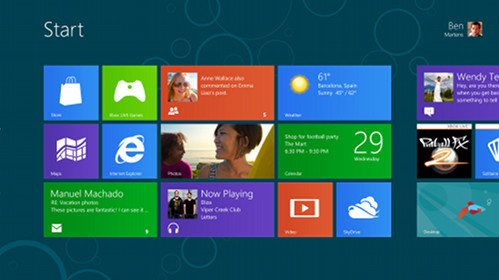
If you decide to use it, this is what Windows 8 will look like.
Windows 8. It’s the forthcoming new version of Microsoft’s overwhelmingly dominant operating system. Due for release in the autumn, it looks designed to bridge the differences between tablet and desktop computers. So, will it retain the features you’re used to, and what will it do for businesses?
If your business still uses Windows XP, Microsoft’s decade-old operating system (and still one of the best it’s ever created), you’ll need to pay special attention to Windows 8. That’s because Microsoft will stop offering security updates for Windows XP in April 2014, pretty much forcing you to upgrade to either Windows 7 or 8.
On the one hand, Windows 7 (the current version) is tried and tested. But Windows 8 is likely to last longer overall – and will offer new features that could benefit your business.
For starters, Windows 8 is aiming to be all things to all users. It aims to bridge the current gap between tablet and desktop computers. As an operating system, you’ll be able to run Windows 8 on a desktop computer, a laptop, a netbook, or a tablet.
Since it combines both a desktop and tablet functions, the question is whether they will all integrate and work together seamlessly. I’ve taken a look at a preview version of Windows 8, and these are the biggest changes I’ve seen so far:
- No more ‘Start’ button. Instead, you’ll be relying on the Windows Metro screen (pictured) which contains ‘tiles’ you can swipe and tap to launch applications.
- Your desktop isn’t so central. Instead of being at the heart of Windows, the desktop will be just another app that you can run from the Windows Metro screen.
- It’ll start faster. Finally, Windows 8 should put an end to those long, frustrating waits to get up and running at the start of the day.
- You’ll have some learning to do. The interface of Windows 8 is going to be substantially different to what’s gone before. Expect a steep learning curve.
- It’ll be good for touchscreens. The new interface is designed for touchscreens, so it should be easy to use by swiping, tapping, pinching and zooming the screen.
- It could be distracting. The home screen can contain newsfeeds, tweets, Facebook updates … all the things that you want to close down when you’re trying to focus.
However, one thing you can rely on is that you’ll still be able to use your favourite productivity tools like in-house software, spreadsheets, accounting software, word processors and graphics software. They should all run faster in Windows 8, too.
Kelly Smith has worked in the IT support industry in Kent for several years and has seen the constantly changing face of technology first hand and its effects on business. She currently works for Barton Technology.



